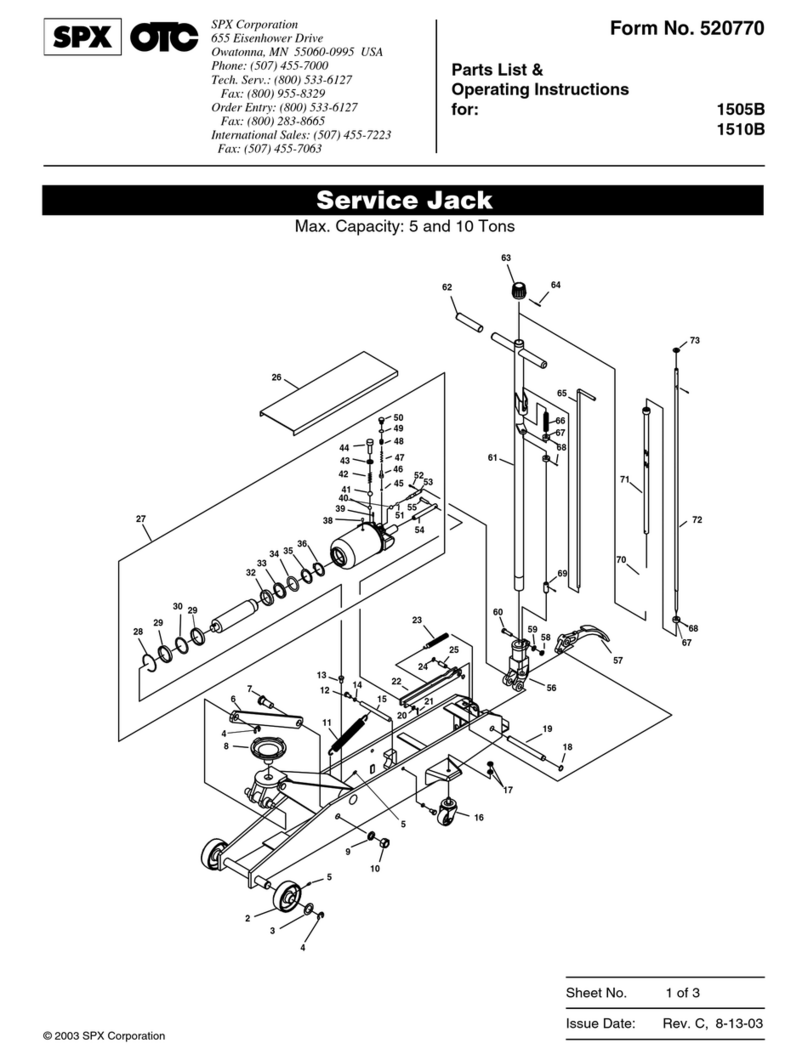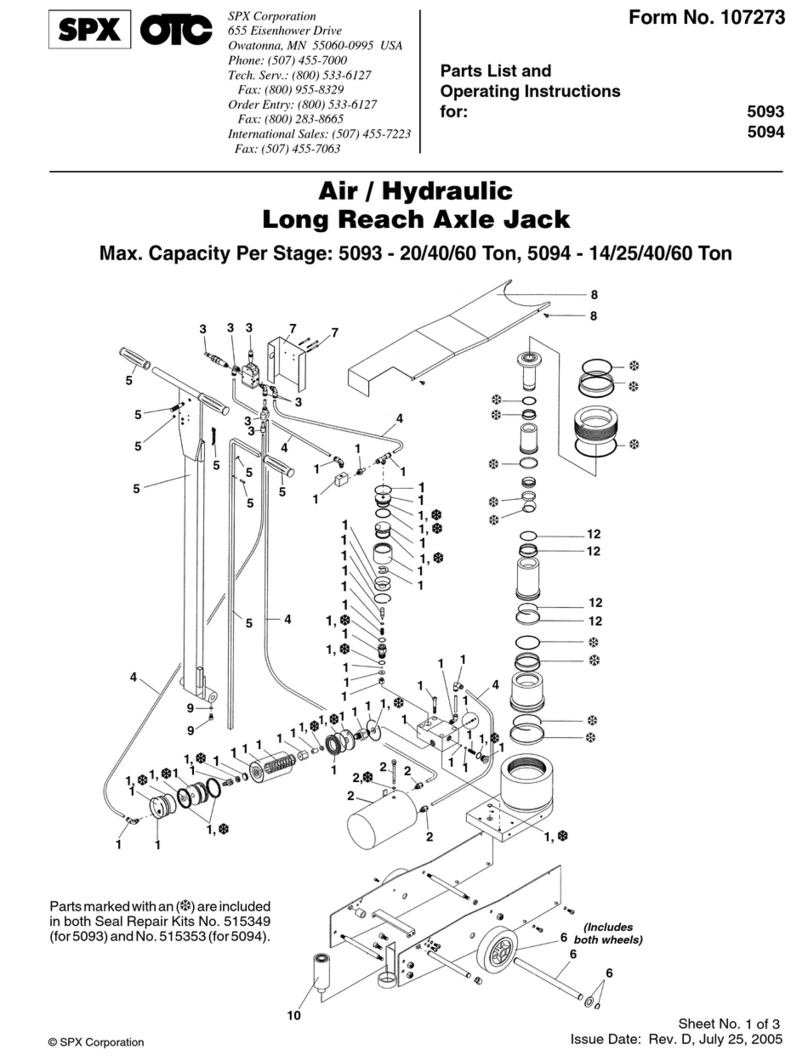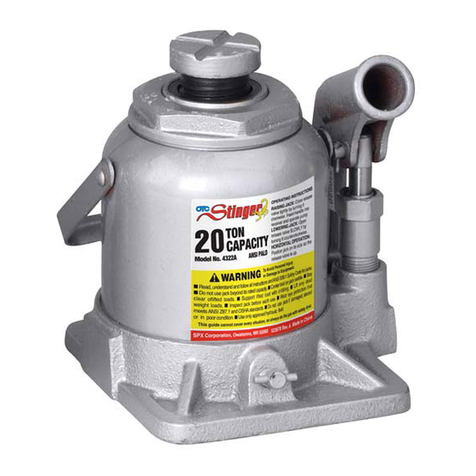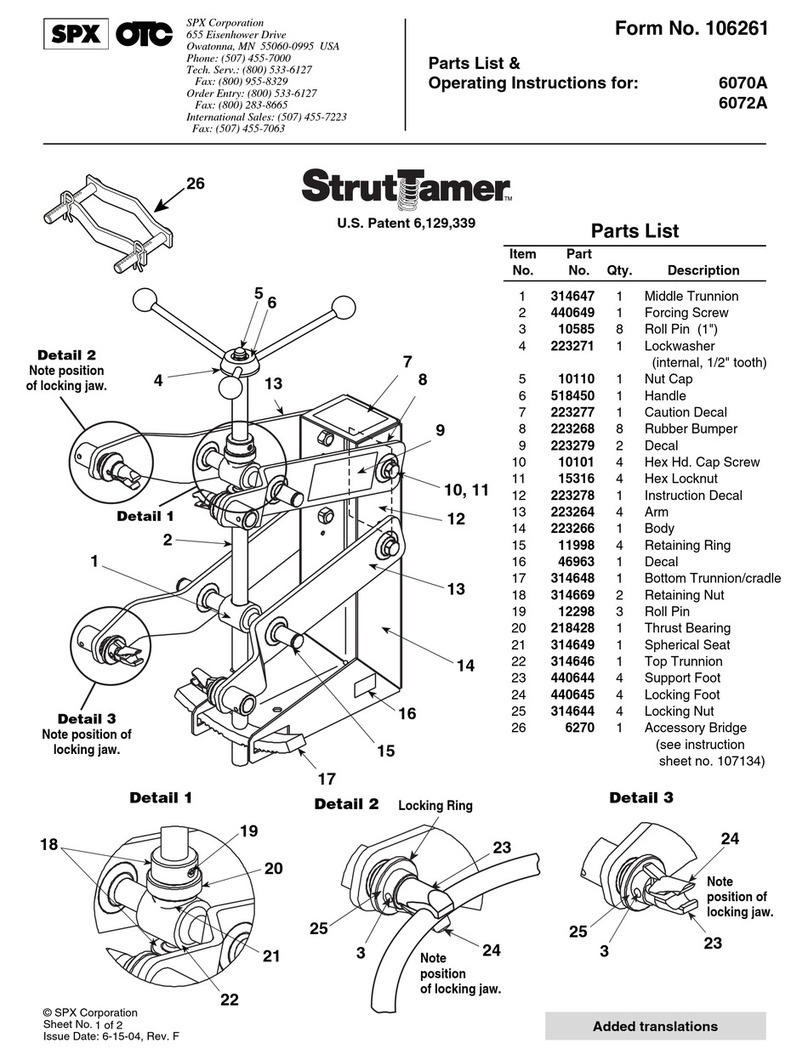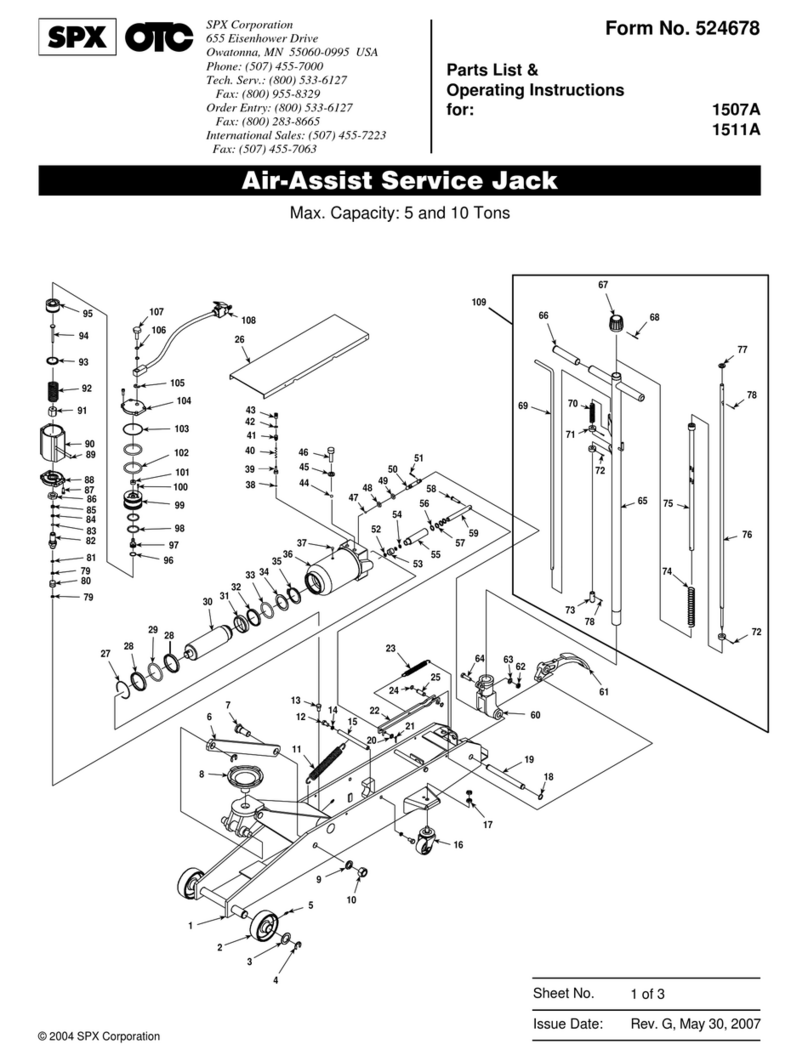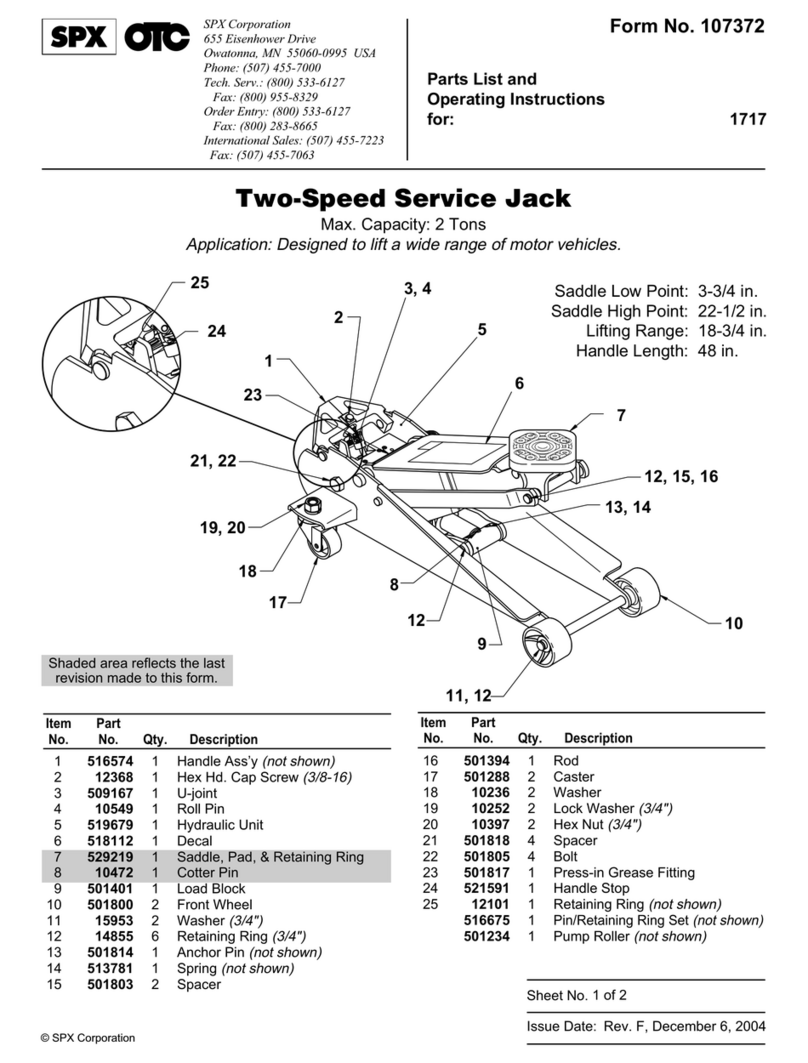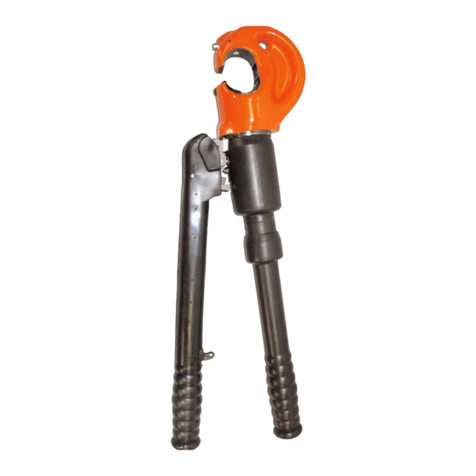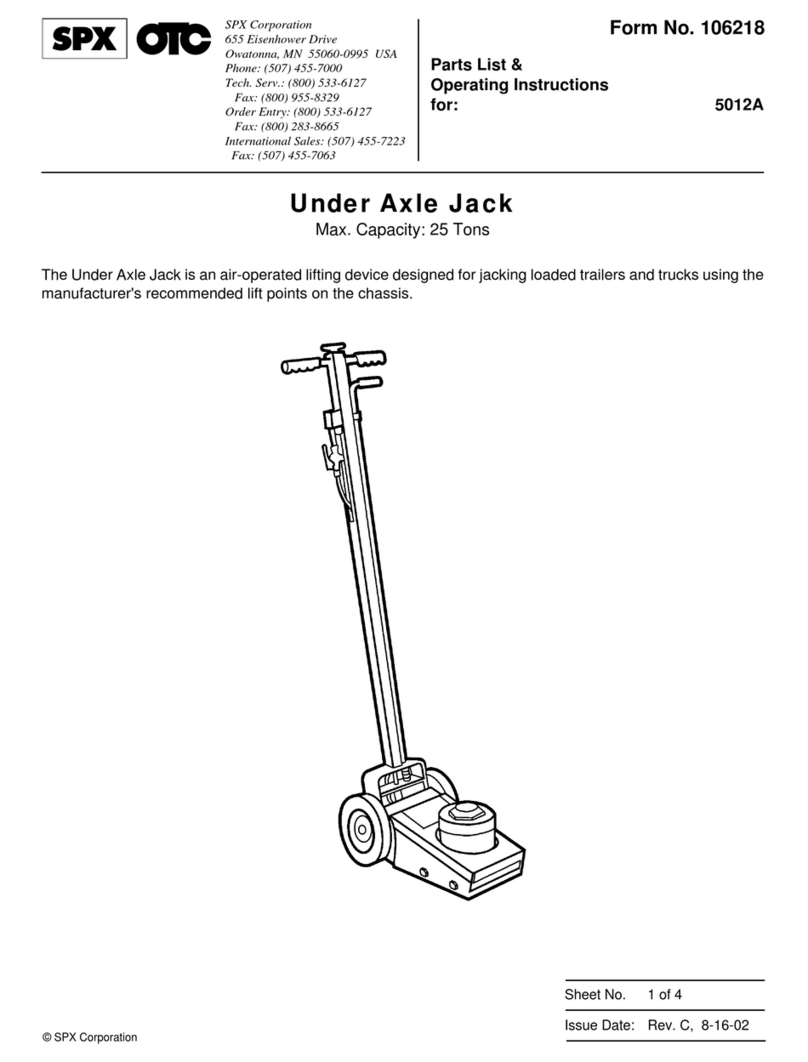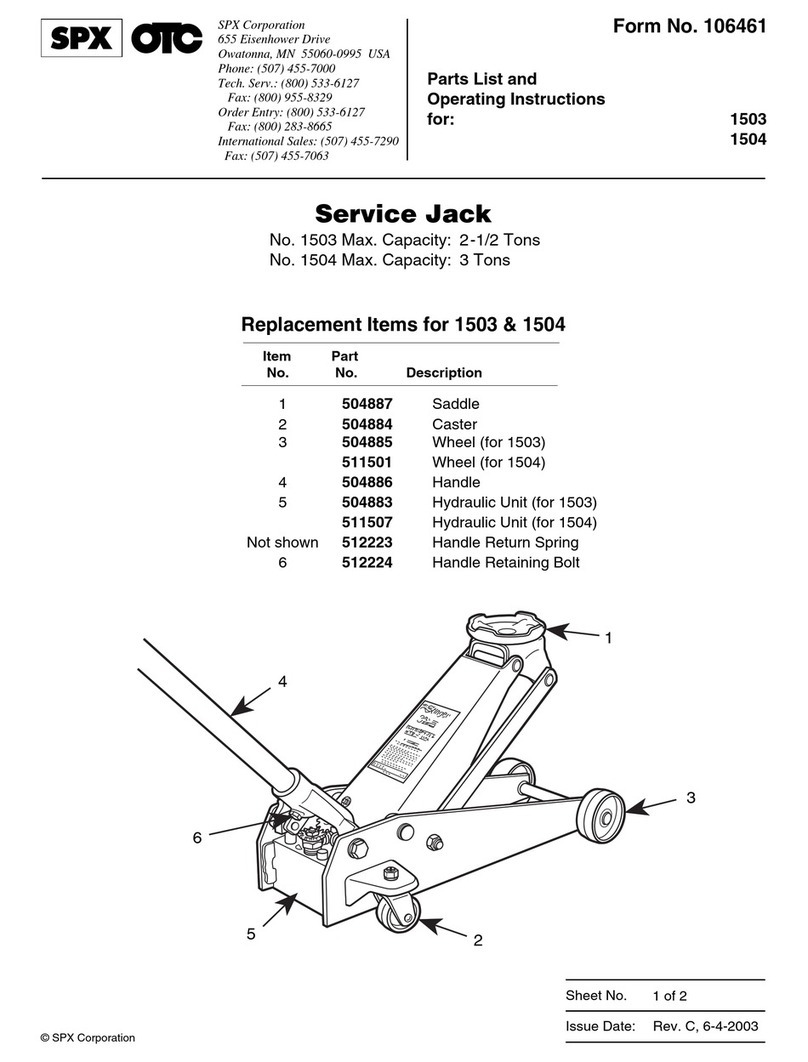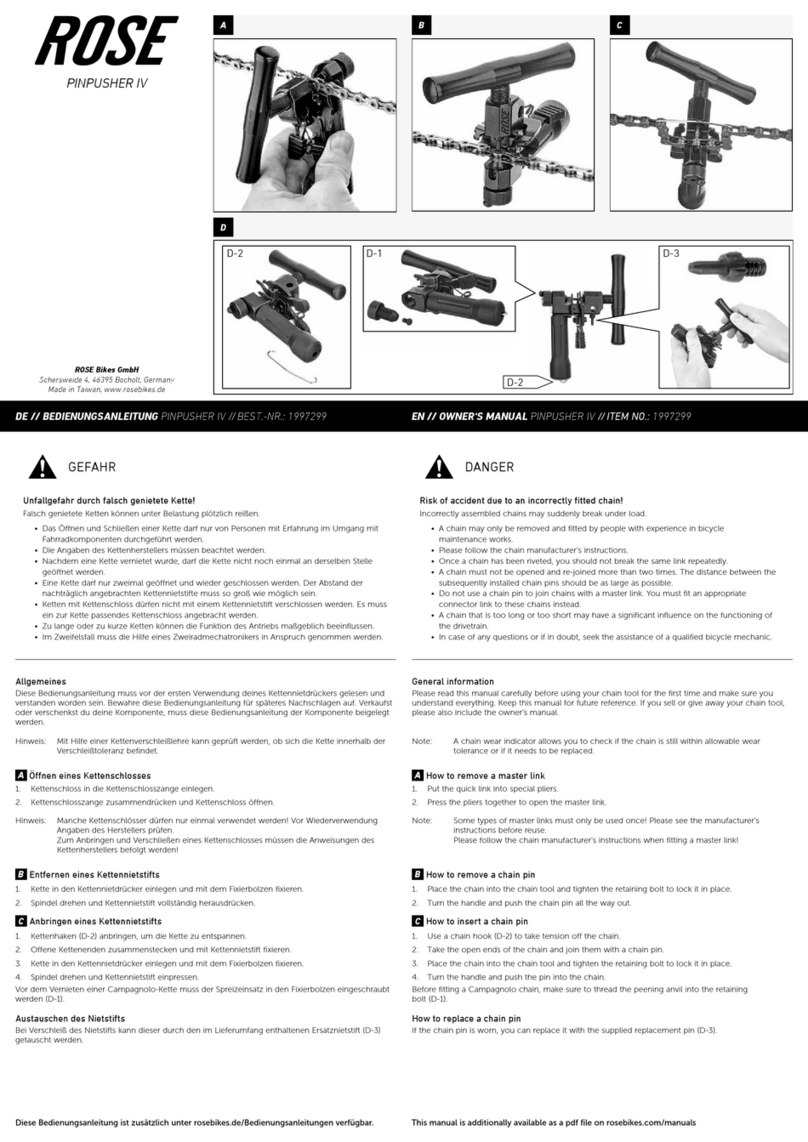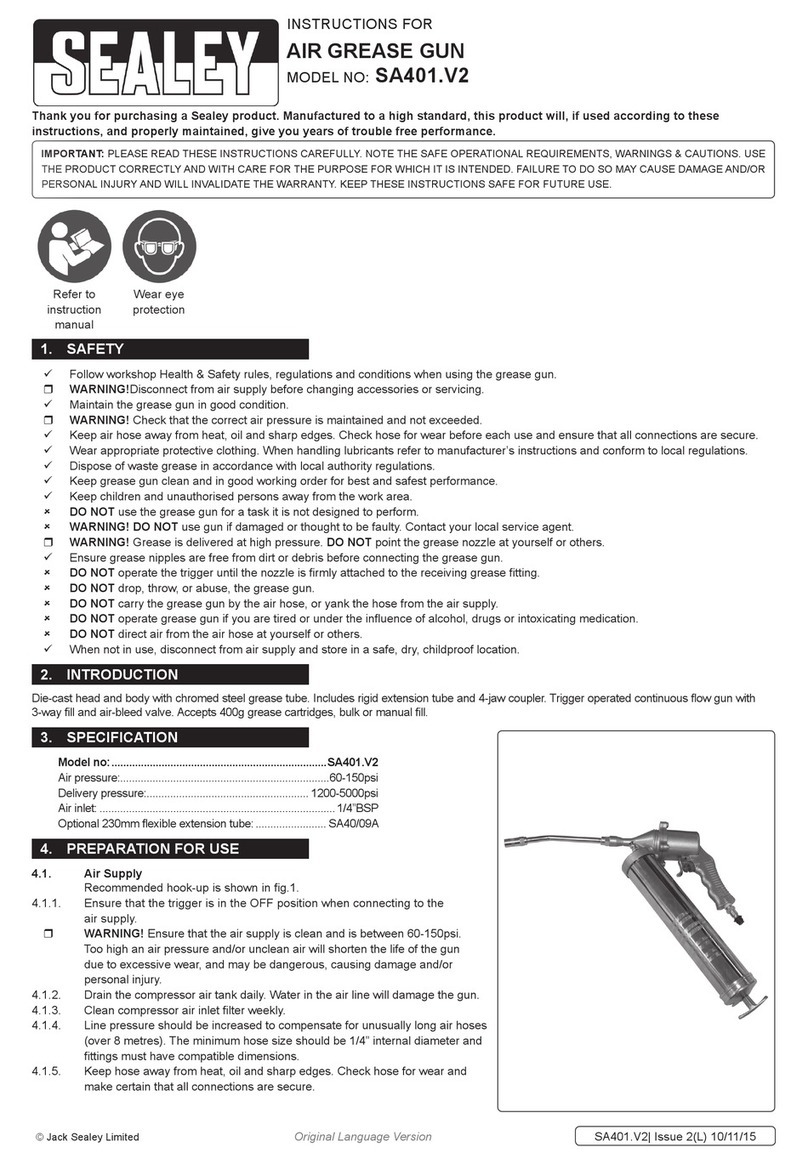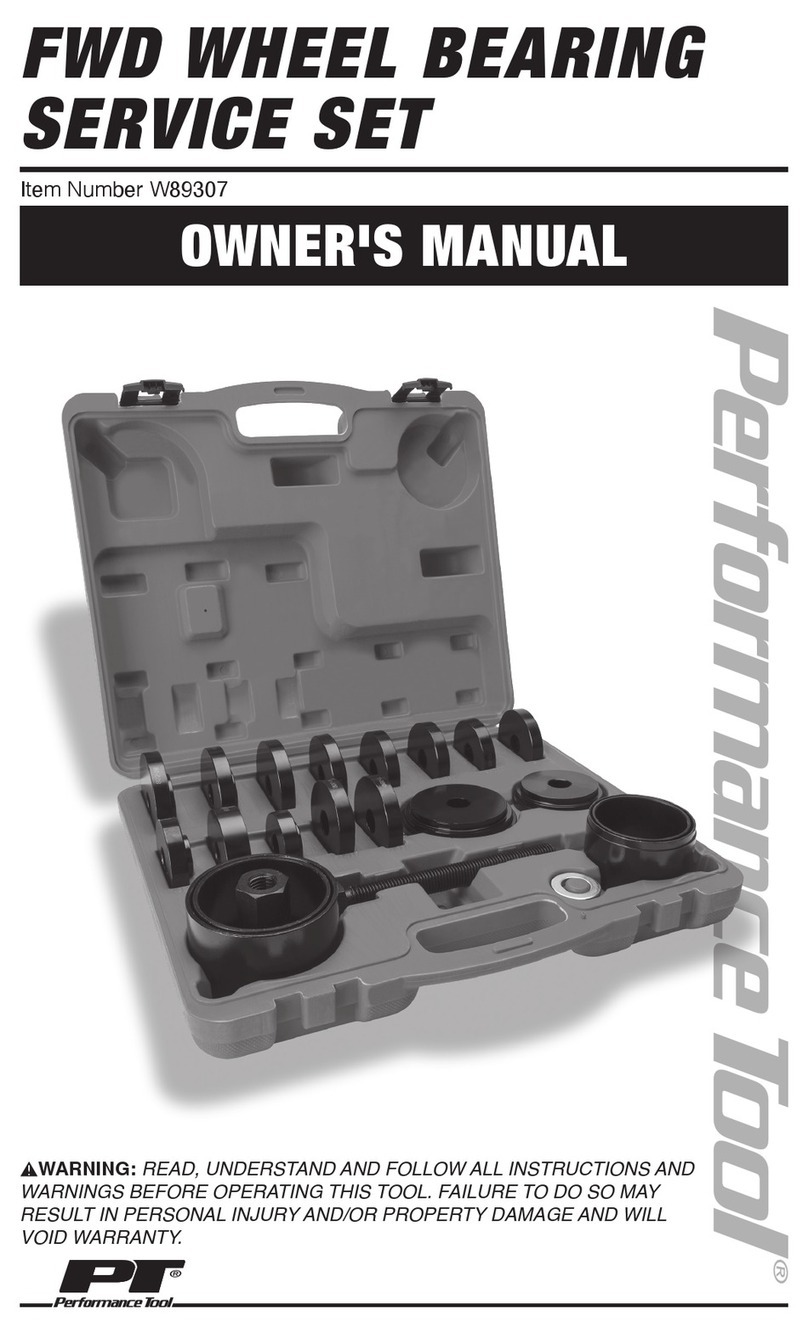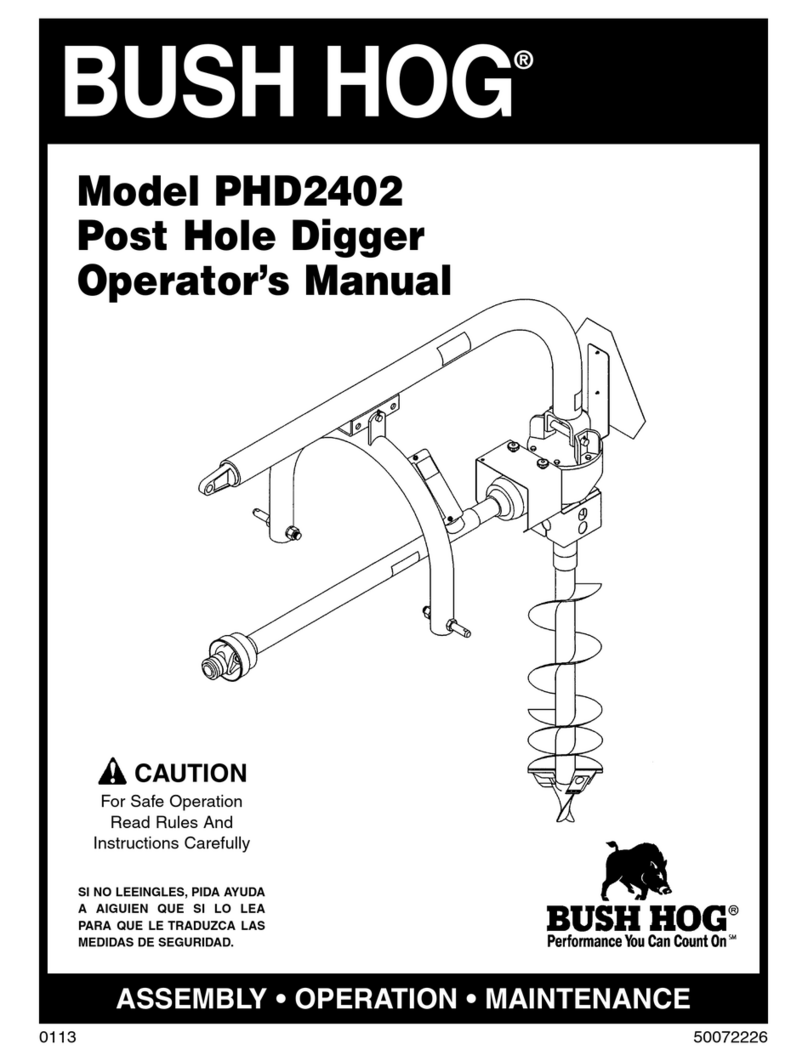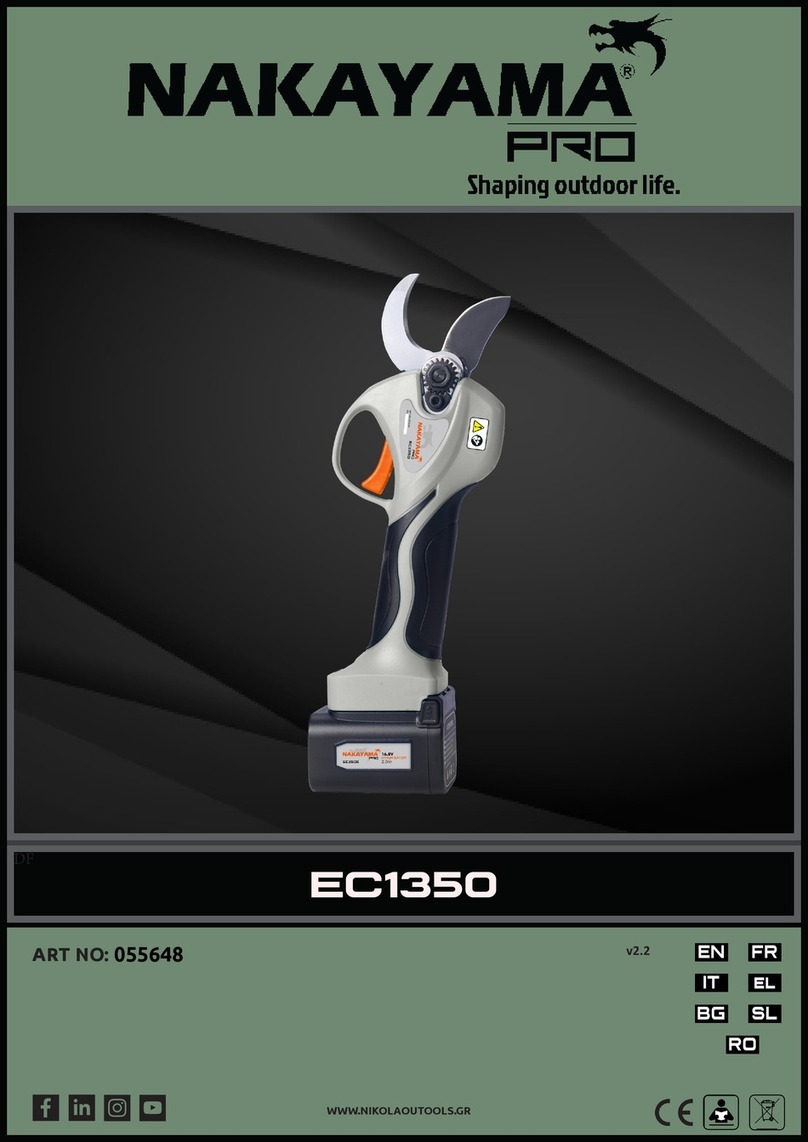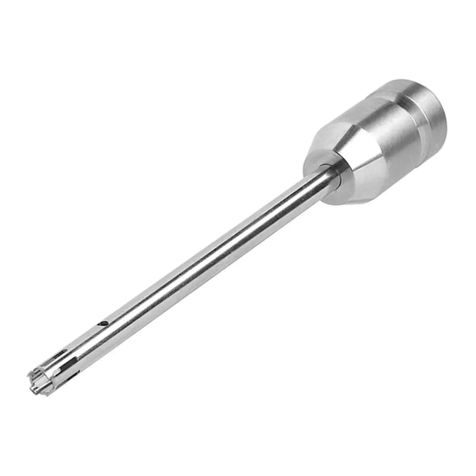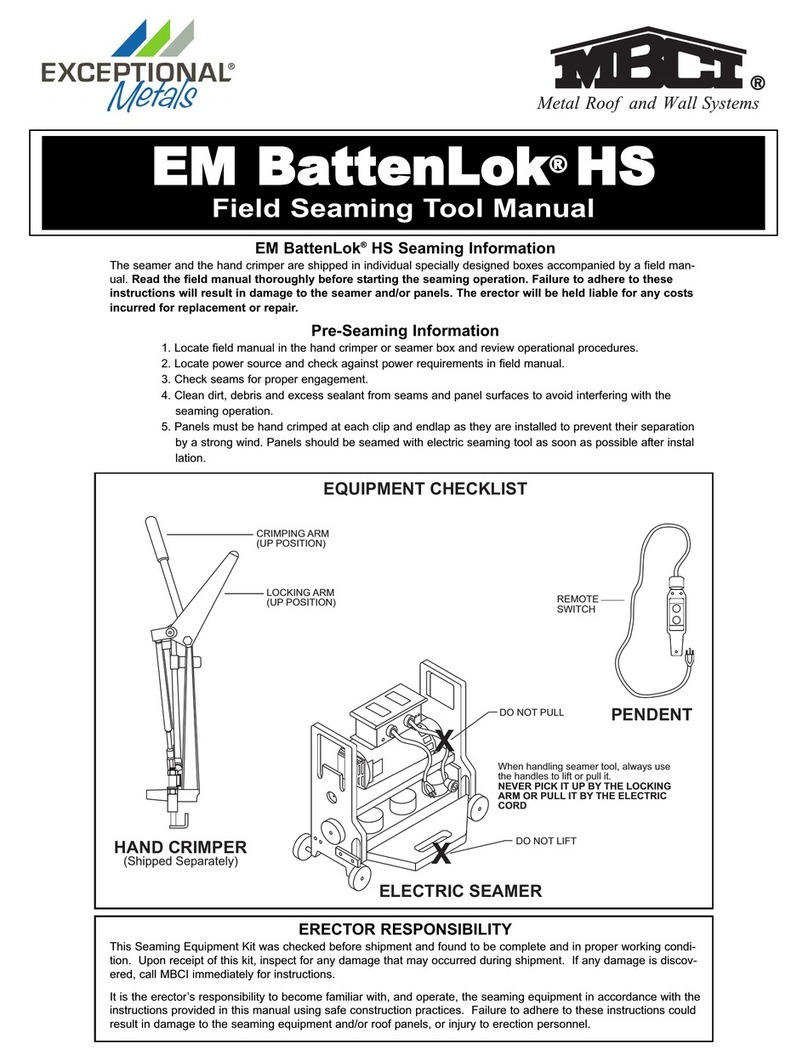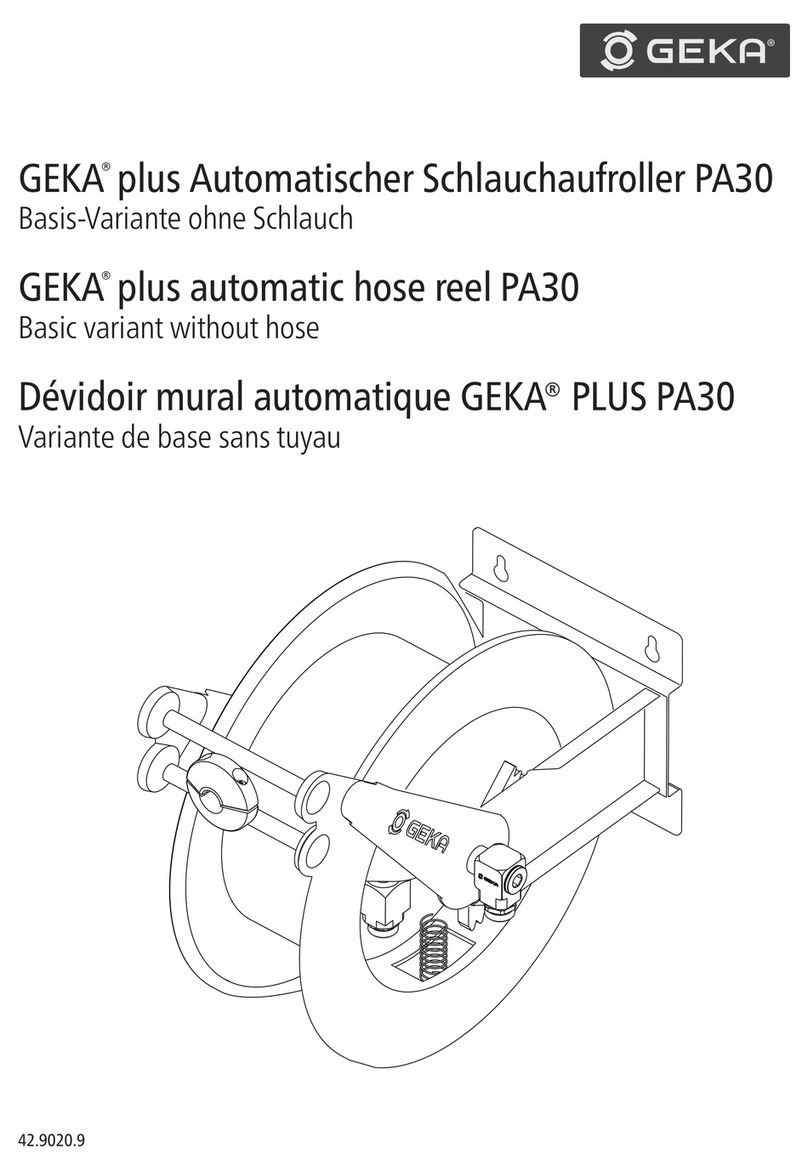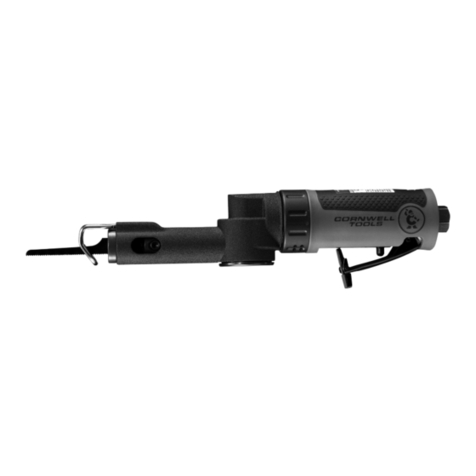SPX 1793 User manual

Sheet No.
Issue Date: 2-14-02 Rev. B
© SPX Corporation
Form No. 106463
Parts List &
Operating Instructions
for: 1793
High Lift Transmission Jack
Max. Capacity: 1,000 lbs.
Application: Installation and removal of automobile transmissions
SPX Corporation
655 Eisenhower Drive
Owatonna, MN 55060-0995 USA
Phone: (507) 455-7000
Tech. Serv.: (800) 533-6127
Fax: (800) 955-8329
Order Entry: (507) 455-6127
Fax: (800) 283-8665
International Sales: (507) 455-7223
Fax: (507) 455-7063
Replacement Items
Item Part Description
No. No.
1 504897 Foot pump
assembly
2 504898 Foot release
assembly
3 504899 Saddle bases
4 504900 Tilt screws
5 504906 Caster
6 504901 Saddle angles
7 504778 Seal kit
1 of 3
Specifications
Capacity 1/2 Ton
Lift Range
Low Height 34"
High Height 70-1/2"
Base Size 33-1/2" x 25"
Saddle Tilt Adjustment
Forward Tilt 24°
Backward Tilt 19°
Left Tilt 20°
Right Tilt 10°
6
6
4
4
4
4
4
4
4
4
4
4
4
4
666
6
6
6
6
6
6
6
66
6
6
6
6
6
6
6
6
6
6
7
7
7
7
7
7
7
7
7
7
7
7
4
4444
4
4
4
4
4
43
3
5
5
5
2
2
22
2
2
2
2
2
2
2
2
11
1
1
1
1
1
1
1
1
1
4

Parts List & Operating Instructions Form No. 106463, Back of Sheet 1 of 3
Parts Details QTY
Cylinder Assembly Cylinder & Base Assembly 1
Legs Legs 2
Bolts 1/2" Allen bolts and spring washers 8
Swivel/Casters Casters with 1/2" nut and spring washer 4
Handle Handle 1
Bolts Hex bolt for handle fastening 2
Saddle Assembly Saddle Assembly including base and board 1
Corner Support Bracket Corner Support Bracket 2
Chain Pack Chain 2
Support Ear with set of 3/8" bolt, nut and washer each 4
Set of 1/2" bolt, nut and washer for corner support 2
bracket fastening
Assembly
Parts in Shipment
WARNING: DO NOT RAISE, LOWER OR TRANSPORT TRANSMISSION UNLESS SECURED
BY THE RESTRAINT SYSTEM. IT IS YOUR RESPONSIBILITY TO ADJUST THE RESTRAINT SYSTEM
TO THE SUITABLE POSITION. OTC IS NOT SUBJECT TO ANY RESPONSIBILITY FOR INCORRECT
SETUPS OF THE RESTRAINT SYSTEM THAT MAY CAUSE PERSONAL INJURY AND/OR PROPERTY
DAMAGE.
10. IMPORTANT: To prevent oil leak during shipment, a shipping plug is used to ensure the best sealing
function. Before using the jack, remove the shipping plug and replace it with the ventilated plug for the
best result.
1. Assemble the swivel casters on the jack legs using spring washers and nuts provided.
2. Assemble the legs (with the casters) to the jack’s base, and slightly secure with the 1/2" Allen socket
bolts and spring washers provided.
3. Position the jack (with legs) on a hard level surface. Tighten the 1/2" Allen socket bolts while all four
casters are contacting the floor and the jack appears vertical to the floor.
4. Locate the handle and the two hex bolts in the carton. Insert the handle bar into its socket on the
cylinder, and secure with the hex bolts provided.
5. Saddle assembly: Loosen the screw from outside the saddle adapter. Mount the saddle adapter onto the
top of the piston rod. Once mounted, tighten the screw and secure entire saddle assembly.
6. Use the tilt adjusting knob to adjust the saddle angle to a relatively horizontal position.
7. Attach the two corner support brackets onto the saddle board, and fasten with the 1/2" hex bolts and
nuts.
8. Locate the support ear in the chain pack. Assemble the support ear on the corner support bracket and
secure with the nuts mounted. Assemble chains and chain hardware to the corner support bracket.
9. The chains and chain hardware are provided to secure the transmission, transfer box, or differential to
the saddle assembly by the different shape of their housing. When using, both ends of the chain should
be anchored to the bracket.
Assembly

Sheet No.
Issue Date: 2-14-02 Rev. B
© SPX Corporation
Parts List & Operating Instructions Form No. 106463
Safety Precautions
Caution: To help prevent personal injury and damage to equipment,
•Read, understand, and follow all safety precautions and operating instructions.
•Wear eye protection that meets the requirements of ANSI Z87.1 and OSHA.
•A load must never exceed the rated lifting capacity of the jack.
•Do not lift or support the vehicle with this jack. Place support stands under the
vehicle before starting repairs.
•Only use the jack on a hard, level surface.
•Centertheloadonthejacksaddle.Off-centerloadscandamagethesealsintheram
and cause jack failure.
•Never move the jack with a load any higher off the ground than necessary. Slowly
and carefully move the jack around corners because the load could tip. Stay clear
of a lifted load.
•Lower the jack slowly and carefully while watching the position of the load.
•Do not modify the jack or use adapters unless approved or supplied by OTC.
•Use only anti-wear hydraulic jack oil with a 215 SUS viscosity rating at 100°F. The
use of alcohol, hydraulic brake fluid, or transmission oil could damage seals and
result in jack failure. This guide cannot cover every situation, so always do the job
with safety first.
Operating Instructions
1. Follow the vehicle's recommended service procedure for removal of the component.
2. Position the jack under the vehicle.
3. Raise the jack by operating the foot pump until the saddle touches the component.
4. Adjust the support brackets to fit the component.
5. Use the tilt crank to align the saddle with the component.
6. Finish raising the jack to the component. Secure the strap assembly around the component.
Setup Instructions
1. Remove the transmission jack from the pallet, and attach the casters using the hex nuts provided.
2. Remove the hex nuts holding the head assembly plate, and replace them with the wing nuts provided.
3. Remove the shipping oil plug, and replace it with the vented oil plug provided.
4. Thereservoirtubeisshippedfilledwithhydraulicoil.Beforeusingthejackforthefirsttime,presstherelease
pedal to open the release valve, and operate the foot pump eight full strokes to distribute the oil.
2 of 3

Parts List & Operating Instructions Form No. 106463, Back of Sheet 2 of 3
Bleeding The Air
The jack may become air bound after shipment. It is possible that you might experience the air
bound condition when pumping the pedal. Air could be trapped in the oil system and in the second
cylinder.
Follow these steps to bleed the air in the oil system:
1. Pump the jack to the highest point where the first and the second piston rams are both
at maximum height.
2. Get the help of another person to keep the release pedal depressed, and
activate the foot pedal about 20 times.
3. Let go of the release pedal; the air in the oil system should be bled
successfully.
Follow these steps to bleed the air in the second cylinder:
1. Locate the air bleeder screw at the top nut, which is on the top of the first
piston rod.
2. Pump the jack to its maximum height. Use an Allen socket wrench to
loosen the air bleeder screw for no more than two 360°turns. Push the saddle
assembly downward to exert the air in the cylinder out until nothing but
oil drains out of the bleeding hole.
3. Tighten the bleeder screw and double check. It may be necessary to repeat the above step several
times.
air bleeder
screw
Maintenance
Regularly lubricate all moving parts of the jack. Pay special attention to the lift screw and related linkages.
1. A medium weight lubricating grease should be used on all external moving parts, such as bearing
surface, pivot points, tilt screws, etc.
2. Regularly check the oil level. With the saddle fully lowered, remove the oil filter screw, and check the oil
level. For units with a filter screw in the reservoir tube, oil should be at the bottom of the filter screw
holes. Fill if necessary.
3. Use only hydraulic jack oil. Do not use hydraulic brake fluid.
4. If the jack fails to operate, check the oil level and/or bleed unit before seeking service.
5. Do not use this jack as a wash rack when washing or steam cleaning transmissions.

Sheet No.
Issue Date: 2-14-02 Rev. B
© SPX Corporation
Parts List & Operating Instructions Form No. 106463
Troubleshooting Guide
Repair procedures must be performed in a dirt-free environment by qualified personnel who are familiar with
this equipment.
Trouble Cause Solution
Unit fails to extend or extends 1. Low fluid level
1. Fill to correct fluid level.
partially
Incomplete or spongy cylinder 1. Low fluid level
1. Fill to correct fluid level.
response when foot pedal is 2. Air in system
2. Follow instructions to bleed air from system.
pumped
Abnormal leakage through 1. Low fluid level
1. Fill to correct fluid level.
unit breather
Unit fails to extend when foot 1. Release valve malfunction
1. Pump foot pedal with release valve open.
pedal is pumped 2. Contamination
2. Disassemble and clean unit.
3. Cylinder packing failure
3. Install repair kit.
Cylinder creeps 1. Load exceeds maximum
1. Reduce load.
lifting capacity
2. Release valve is leaking
2. Flush release valve by pumping foot pedal
with release valve open.
Cylinder doesn't retract when 1. Light load
1. Unit requires 35 lbs. to return.
release pedal is activated 2. Cylinder is binding
2. Disassemble unit; replace defective parts.
Cylinder doesn't extend 1. Contamination
1. Disassemble and clean unit.
2. Bad packing
2. Install repair kit.
Cylinder extends when foot pedal 1. Release valve malfunction
1. Flush release valve by pumping foot pedal
is pressed, and retracts as foot
with release valve open.
pedal retracts 2. Contamination
2. Disassemble and clean unit.
Refer to any operating instructions included with the product for detailed information about operation, testing,
disassembly, reassembly, and preventive maintenance.
Items found in this parts list have been carefully tested and selected by OTC. Therefore: Use only OTC replacement parts!
Additional questions can be directed to the OTC Technical Services Dept.
3 of 3
Table of contents
Other SPX Tools manuals

SPX
SPX Power Team J58T User manual
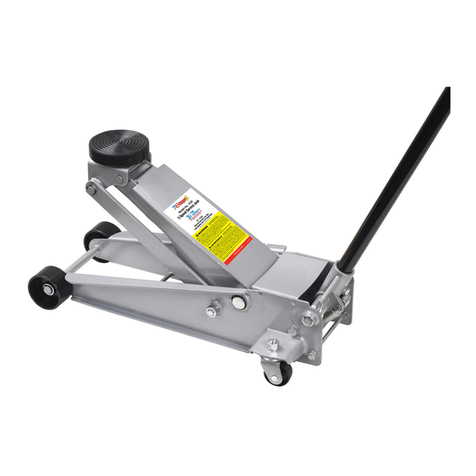
SPX
SPX 1526 User manual
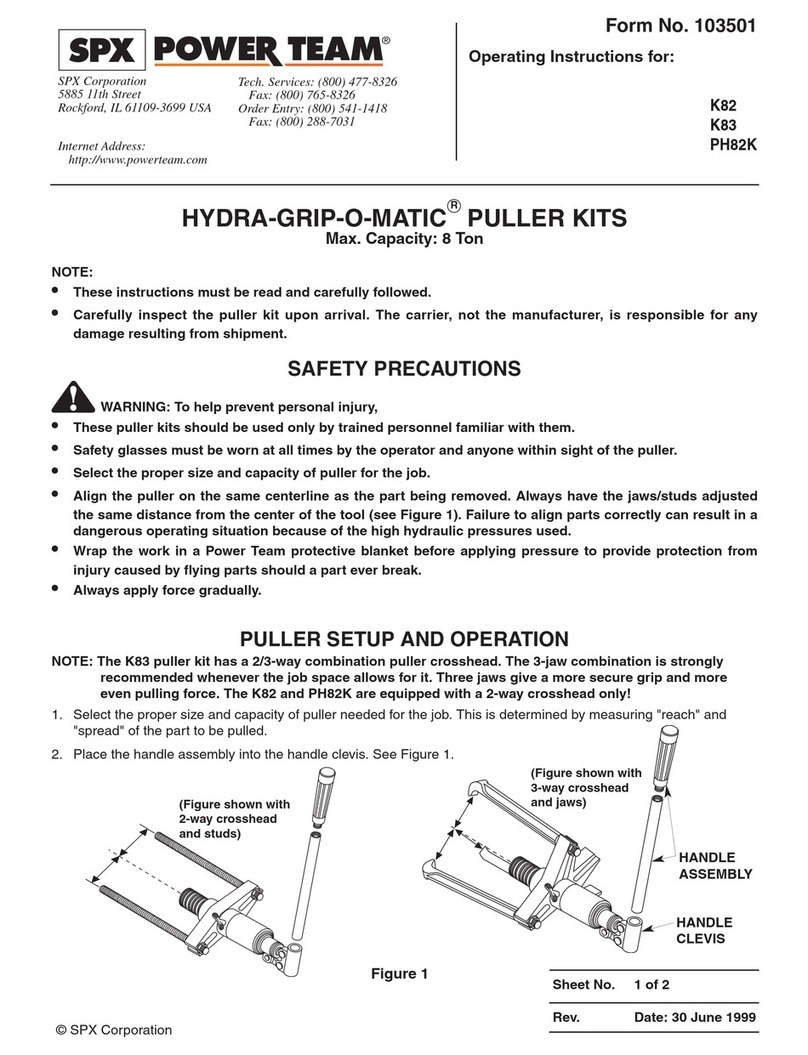
SPX
SPX HYDRA-GRIP-O-MATIC K82 User manual

SPX
SPX 5019 User manual

SPX
SPX OTC 6980 User manual
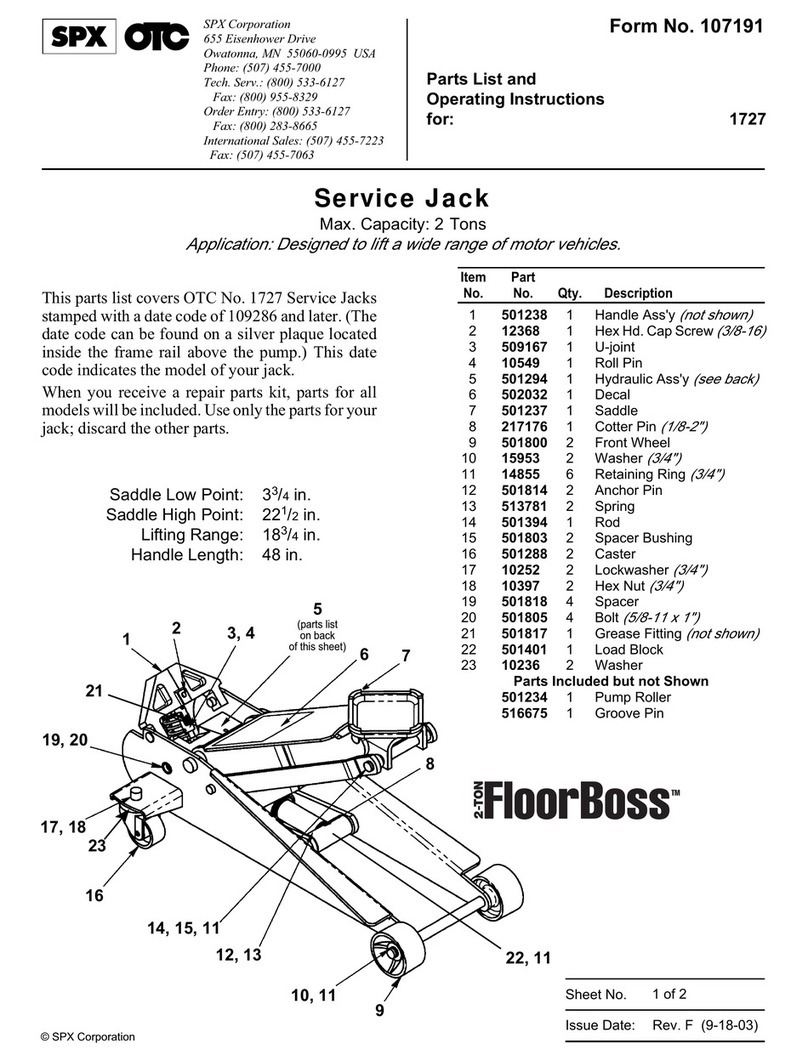
SPX
SPX 1727 User manual
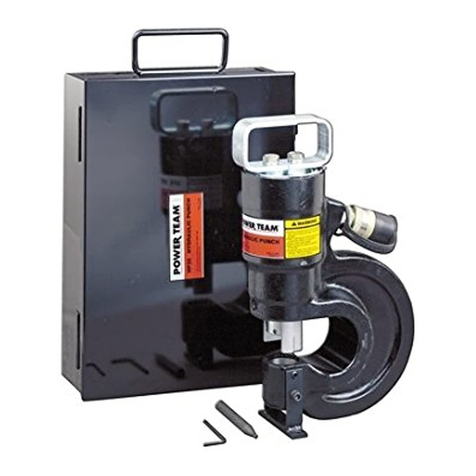
SPX
SPX Power Team HP20 User manual

SPX
SPX 5106 User manual
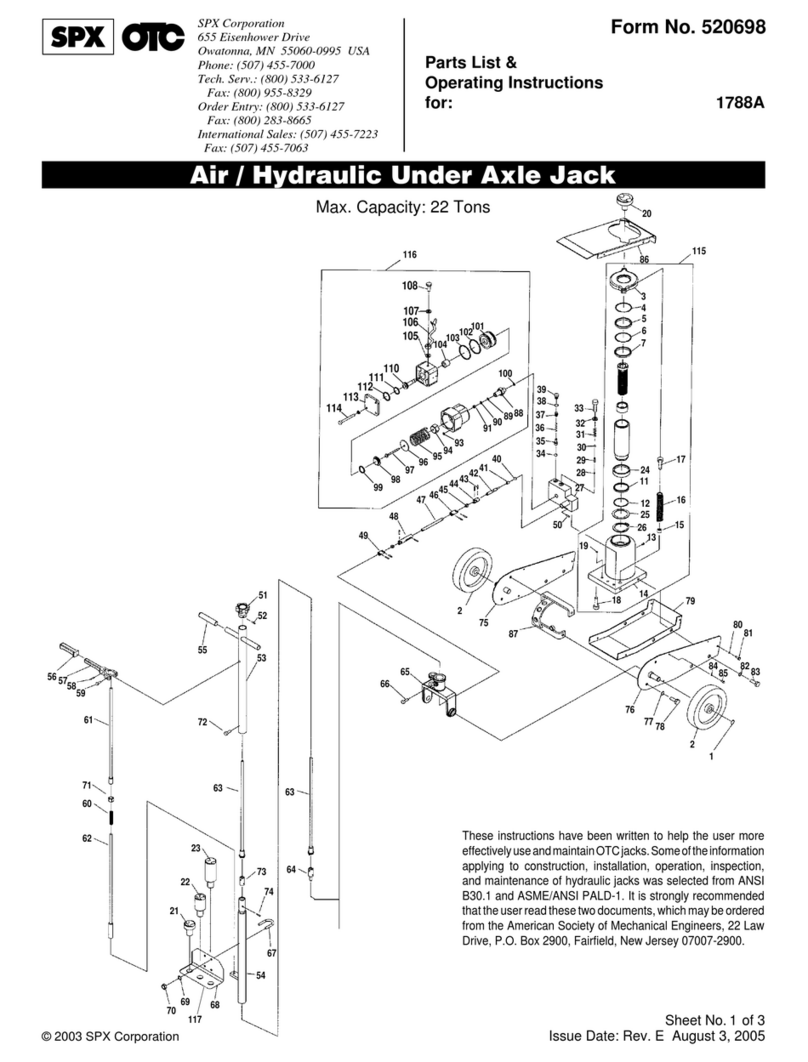
SPX
SPX 1788A User manual
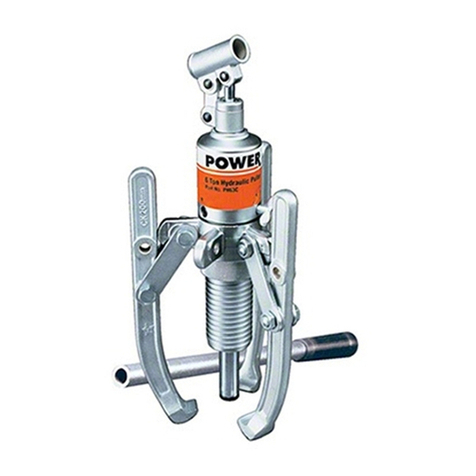
SPX
SPX Power Team HYDRA-GRIP-O-MATIC PH6 User manual
